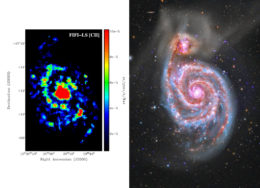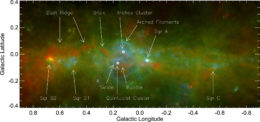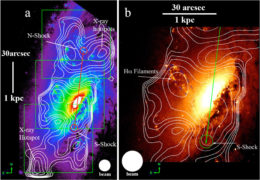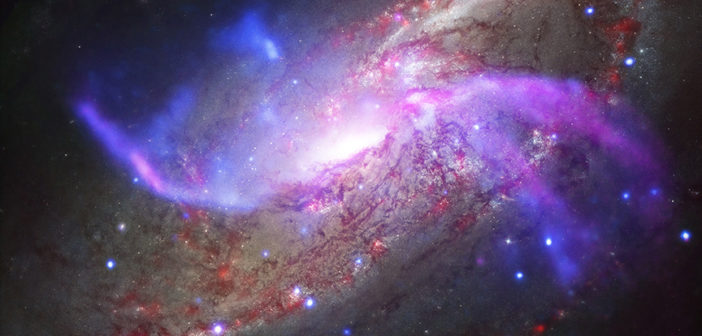In December, AAS Nova Editor Susanna Kohler had the opportunity to fly aboard the NASA/DLR Stratospheric Observatory for Infrared Astronomy (SOFIA). This week we’re taking a look at that flight, as well as some of the recent science the observatory produced and published in an ApJ Letters Focus Issue.
One of SOFIA’s great strengths is that the instruments mounted on this flying telescope can be easily swapped out, allowing for a broad range of infrared observations. Three of SOFIA’s instruments are featured in science recently published in the ApJ Letters Focus Issue: the Far Infrared Field-Imaging Line Spectrometer (FIFI-LS), the High-Resolution Airborne Wideband Camera Plus (HAWC+), and the Echelon-Cross-Echelle Spectrograph (EXES).
Meet FIFI-LS
FIFI-LS is a German-built instrument that can record spectra for each pixel of its field of view simultaneously, exploring objects in two far-infrared channels: 51–120 µm and 115–203 µm. Many astronomically interesting emission lines fall into these ranges — particularly those that trace the formation of massive stars and the properties of the interstellar medium.
By simultaneously capturing both images and spectra, FIFI-LS is able to deeply probe the composition and physical properties (like pressure and temperature) of heavily dust-obscured, star-forming regions in our own galaxy, as well as those in nearby external galaxies and galactic nuclei.
Some Recent FIFI-LS Science
In a study led by Gerold Busch (University of Cologne, Germany), scientists detail the first detection with FIFI-LS of a nearby luminous AGN, or active galactic nucleus. Despite its relative nearness, this galaxy is still roughly 500 million light-years away, making it the most distant object ever studied with SOFIA.
The team compares FIFI-LS’s spatially resolved observations of the infrared emission line [CII] in the galaxy to optical observations of Hα, an emission line known to trace star formation. By demonstrating that the two different types of emission occur in the same places in the galaxy, the team shows that [CII] emission can be used as a powerful diagnostic tool for tracing star formation even in distant galaxies — and even when those galaxies host luminous active nuclei.
••••••

Left: FIFI-LS image of [CII] emission from M51. Right: X-ray, optical, and infrared composite image of M51. The deficit of [CII] emission from the upper companion galaxy suggests it has a much lower star formation rate. [Left: Adapted from Pineda et al. 2018; Right: X-ray: NASA/CXC/SAO; Optical: Detlef Hartmann; Infrared: NASA/JPL-Caltech]
••••••
The molecular cloud BYF 73 is currently collapsing in on itself, making it a promising target in which to watch the formation of massive stars. In a study led by Rebecca Pitts (University of Florida), scientists have gathered multi-wavelength observations of this nursery, including mid-infrared data from FIFI-LS. The observations reveal the presence of eight very young (around just 7,000 years old), very massive protostars (the largest is ~240 times the mass of the Sun) embedded in the center of the cloud — providing an excellent opportunity to learn about the early stages of massive star formation.
••••••

Three-color image of the galactic center indicating the position of the luminous HII region Sgr B1. HII regions are shown in blue. Click to enlarge. [Simpson et al. 2018]
In a study led by Janet Simpson (SETI Institute), scientists use FIFI-LS observations to explore one such puzzle: the luminous HII region Sgr B1. Sgr B1 is predicted to have passed by Sgr A* around 1.5 million years ago, yet FIFI-LS’s measurements show that the stars in this region are closer to 4 million years old. This suggests the stars actually formed in a separate cluster — now dispersed — that had an earlier star-forming passage by Sgr A*.
••••••

A zoomed-out (left) and zoomed-in (right) view of NGC 4258’s center, with contours of the [CII] emission superimposed on false-color representations of Hubble data. The [CII] emission is associated with the shocks and turbulence in the galaxy’s jets, which are marked by the line ending in two circles. [Appleton et al. 2018]
Citation
ApJL Focus Issue:
Focus on New Results from SOFIA
FIFI-LS articles:
“The Close AGN Reference Survey (CARS): SOFIA Detects Spatially Resolved [C ii] Emission in the Luminous AGN HE 0433-1028,” G. Busch et al. 2018 ApJL 866 L9. doi:10.3847/2041-8213/aae25d
“A SOFIA Survey of [C ii] in the Galaxy M51. I. [C ii] as a Tracer of Star Formation,” Jorge L. Pineda et al. 2018 ApJL 869 L30. doi:10.3847/2041-8213/aaf1ad
“Gemini, SOFIA, and ATCA Reveal Very Young, Massive Protostars in the Collapsing Molecular Cloud BYF 73,” Rebecca L. Pitts et al. 2018 ApJL 867 L7. doi:10.3847/2041-8213/aae6ce
“SOFIA FIFI-LS Observations of Sgr B1: Ionization Structure and Sources of Excitation,” Janet P. Simpson et al. 2018 ApJL 867 L13. doi:10.3847/2041-8213/aae8e4
“Jet-related Excitation of the [C ii] Emission in the Active Galaxy NGC 4258 with SOFIA,” P. N. Appleton et al. 2018 ApJ 869 61. doi:10.3847/1538-4357/aaed2a

